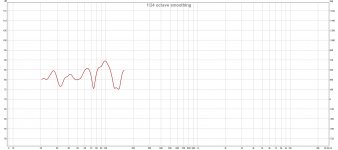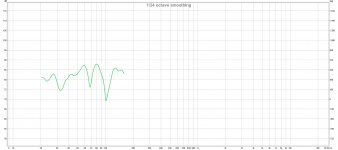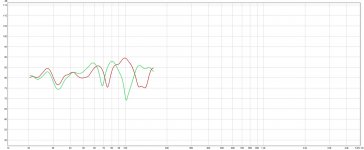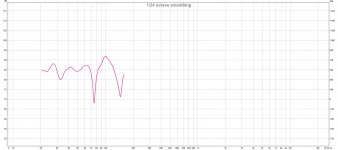Is it possible to integrate the sub seamingless when it's placed behind the listener?
Can't say if you head is only inches, but at a few feet at least, any crossover to 120 Hz is undetectable if the slope is 24 dB or better and you don't have harmonic distortion products (or really really tiny).
Been doing it for years. No directionality impairment on music except in your mind.
Ben
Is one sealed and another vented if so thats the issue and the tuning is likely around 40Hz where phase goes positive to negative.
Is it possible to integrate the sub seamingless when it's placed behind the listener?
I have my larger subs at the rear of the room, partially because they're horns with a small delay and partially because if placed at the front I end up exciting a null the size of a city bus, but it all seems to integrate well. You just have to pay extra attention to crossover frequency and levels.
An arrangement that works well is how I've got my subs placed for music. I have my larger T-TQWT subs at the back of the room and my smaller corner loaders at the front. When they all play together, it's quite seamless...and actually a neat effect where frequencies below 50 hz or so just seem to wash over you, where it just comes from everywhere.
I might try your two subs one in the center up front between your mains and the other behind you in the center.
This looks more like phase canclation. I don't think bass traps will solve this problem. Looks like one is out of phase. Try messing with that and add another sub for better smoothing. When that is fixed, then you can go back and measure decay time, then fix that with good traps.
DUH!!!!
This is what happens in a room. Any room. You can move them around so the nulls and peaks are in different places. You can play with phase and delays to move the nulls around. All this just shifts them.
To reduce them, you can build massive bass traps or you can move outside. That is about it. Welcome to acoustics 101.
So, to the OP, put your measurement stuff away and move the subs around until you like what you hear when you are sitting where you usually do.
I had one room with fantastic bass. It was a trailer and the walls were just about transparent to bass, so it was like living outside. I liked it, but I doubt the rest of the park did. 😀
DUH!!!!
This is what happens in a room. Any room. You can move them around so the nulls and peaks are in different places. You can play with phase and delays to move the nulls around. All this just shifts them.
All kinds of weird and wonderful and unpredictable results moving subs around and playing (yes, playing) with the phase. I think evidence in Toole says likewise.
BTW, I looked at the first set of curves in this thread. Clearly above 50 Hz there was mutual reinforcement - that part didn't look like phase negation at least to my eyeballs. Just happens I have some idea about the lengths of waves and with the speakers (in the picture) touching one another you'd have substantial cancellation way up the compass, but it didn't seem like a phase issue, "duh" or not.
Ben
Last edited:
Another question.
I'm working now on a different setup (hometheater). Measuring a midbass/sub. I'm getting a different response using different power amp for the sub. Exactly same placement. Is this also caused by phase or why is this happening?
The red one is with a Crown XTi 2000 (DSP is off) and the green with Hypex UcD 400 module.
Added an overlay.
I'm working now on a different setup (hometheater). Measuring a midbass/sub. I'm getting a different response using different power amp for the sub. Exactly same placement. Is this also caused by phase or why is this happening?
The red one is with a Crown XTi 2000 (DSP is off) and the green with Hypex UcD 400 module.
Added an overlay.
Attachments
Ok. I was measuring the fronts at the same time. Measuring the fronts and the sub I get a different response using different amps. 😕
I also tried with a Hypex Ncore and got another one.
If I measure the sub alone though, I get the exact same response with all three amps. But why the different responses when including my fronts?
I also tried with a Hypex Ncore and got another one.
If I measure the sub alone though, I get the exact same response with all three amps. But why the different responses when including my fronts?
Attachments
Sounds like a latency issue, perhaps the amps have different delay times even when processing/ filters are "off".Ok. I was measuring the fronts at the same time. Measuring the fronts and the sub I get a different response using different amps. 😕
I also tried with a Hypex Ncore and got another one.
If I measure the sub alone though, I get the exact same response with all three amps. But why the different responses when including my fronts?
I suspect the hitch is a thousand pages earlier in the book on sound reproduction.Sounds like a latency issue, perhaps the amps have different delay times even when processing/ filters are "off".
Ben
I When you include your fronts, they are interacting with the subs. Remember, crossovers have a slope. Even higher frequencies effect the sub response. It's called modulation. You are not adding lines on a chart. You are adding pressure waves in a room.
Still, I don't quite see how that explains the change in response with different power amps. The crossover is the same. Is it delay that was mentioned?I When you include your fronts, they are interacting with the subs. Remember, crossovers have a slope. Even higher frequencies effect the sub response. It's called modulation. You are not adding lines on a chart. You are adding pressure waves in a room.
Makes it also difficult to compare power amps to the subs, something I've planning to do. Curious to whether class D sounds better for subs then a PA crown amp. But if the response is changing, I'm not gonna know what I'm hearing when comparing.
Still, I don't quite see how that explains the change in response with different power amps. The crossover is the same. Is it delay that was mentioned?
Makes it also difficult to compare power amps to the subs, something I've planning to do. Curious to whether class D sounds better for subs then a PA crown amp. But if the response is changing, I'm not gonna know what I'm hearing when comparing.
About amps, I honestly believe that if tested blind nobody can hear any difference between any respectable HiFi amp produced in the last 30 years. I have three Class G Kenwood amps from early 80s that I bought recently to replace JVC amps from the 70s. While I don't think anybody can hear shortcomings in a 70s design amp due to design shortcomings, the parts are getting old.
But stuff designed for PA work is made for some other purposes as well as for sound quality. Different world.
About your mystery, I can only say you are overlooking something that might be obvious in your set-up (like reversed phasing on speaker connections.... or including screwy wiring inside speakers that ought to be identical). This "delay" theory in amps has to do with microseconds (if it exists at all as an audible experience). There may be all kinds of acoustic interactions in a room, depending on a lot of genuinely unfathomable factors.
Ben
Last edited:
- Status
- Not open for further replies.
- Home
- Loudspeakers
- Subwoofers
- Why I'm seeing a null with two subs?



